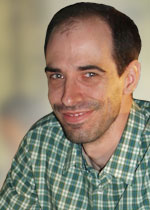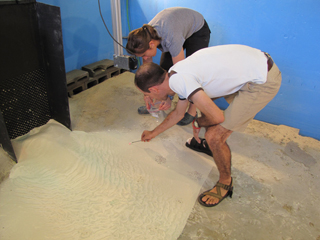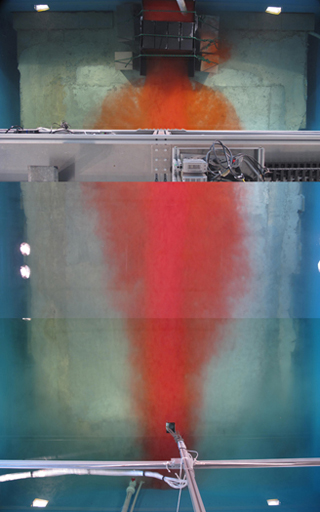57th Annual Report on Research 2012 Under Sponsorship of the ACS Petroleum Research Fund
Dr. Kyle Straub
 Department of Earth and Environmental Sciences
Department of Earth and Environmental Sciences
Tulane UniversityQuantifying the Morphology and Composition of Thin-bed Levee Deposits in Deep-water Settings
Dr. Kyle Straub studies the movement of sediments through channels on the ocean floor, and compares them to motion of river sediments. Straub says that, "the big research question that I'm trying to address is how do submarine channels initiate, and how do they evolve?" After earning his Ph.D. in Geology and Geochemistry from the Massachusetts Institute of Technology, and a post-doctoral fellowship at the National Center for Earth-Surface Dynamics in Minneapolis, Straub accepted a position as an Assistant Professor of Earth and Environmental Sciences at Tulane University. "The first thing I had to do at Tulane was build a state-of-the-science sediment transport lab, because a lot of my research is doing physical experiments and connecting these to numerical models."
Large river systems - like the Amazon, Niger, and Mississippi - have channels which cut across the continental shelf and connect to submarine canyons, which can extend for thousands of kilometers past the shelf edge. Submarine canyons allow suspended sediment to move through the continental shelf and slope, with the finest-grained sediments deposited in submarine fans on the abyssal plains of the ocean basins.
In map view, submarine channels may look very similar to rivers, but their cross-sectional views are significantly different. River channels are erosional features cut into the landscape, with channel-defining levees formed by eroded and redeposited sediment. In contrast, Straub has shown that deep-sea submarine channels are largely aggradational features, because the channel floor is at the same elevation as the adjacent seafloor outward of the levees. According to Straub, "the research that I've been doing on this grant is trying to understand how levees evolve and form, from a perspective of understanding the sediment concentration profile within a channel." By combining laboratory experiments with numerical models, he hopes to understand how "channels work in a submarine environment, where the governing physics is relatively different from terrestrial rivers."
The ultimate goal of his research is to understand how beds form and evolve in submarine channels, and to produce a quantitative understanding of seafloor morphology by developing seascape evolution models. Since hydrocarbon deposits may be found in thin-bedded coarser-grained deposits that form along the sides of submarine channels and levees, Straub has obtained additional research funds from Shell Petroleum on a very similar research line. Petroleum exploration companies hope to understand how these beds evolve, and to determine if levee deposits might be hydraulically connected to other thin coarse beds above and below them, as these sediments may be potential reservoir rocks for petroleum.
Straub was awarded the James Lee Wilson Award [http://www.sepm.org/pages.aspx?pageid=74] for excellence in sedimentary geology by a younger geoscientist, presented by the Society for Sedimentary Geology (SEPM) at its 2013 annual meeting. "The first grant that I received to actually do science came from ACS PRF, and that grant helped me demonstrate the capabilities of my lab and for me as an independent researcher."
Grant 50295-DNI8: Read Straub's Annual Report
 Graduate student Chris Esposito examines Tulane Deepwater Basin used for experiments on deep-water channelized flow and deposition of continental slope delta and submarine sediments.
Graduate student Chris Esposito examines Tulane Deepwater Basin used for experiments on deep-water channelized flow and deposition of continental slope delta and submarine sediments. Dye added to flume allows study of channelized flow by turbidity currents under various water discharge conditions.
Dye added to flume allows study of channelized flow by turbidity currents under various water discharge conditions. Dr. Straub and Colorado School of Mines graduate student Jane Stammer examine sediment deposited by turbidity currents.
Dr. Straub and Colorado School of Mines graduate student Jane Stammer examine sediment deposited by turbidity currents. Preserved stratigraphy and sediment layers in turbidity current deposits.
Preserved stratigraphy and sediment layers in turbidity current deposits. Submarine levee growth via channelized turbidity current may be observed.
Submarine levee growth via channelized turbidity current may be observed. Turbidity current in Deepwater Basin.
Turbidity current in Deepwater Basin.









